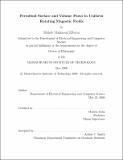Ferrofluid surface and volume flows in uniform rotating magnetic fields
Author(s)
Elborai, Shihab M. (Shihab Mahmoud), 1977-
DownloadFull printable version (4.304Mb)
Other Contributors
Massachusetts Institute of Technology. Dept. of Electrical Engineering and Computer Science.
Advisor
Marcus Zahn.
Terms of use
Metadata
Show full item recordAbstract
Ferrofluid surface and volume effects in uniform dc and rotating magnetic fields are studied. Theory and corroborating measurements are presented for meniscus shapes and resulting surface driven flows, spin-up flows, and Hele-Shaw cell flows and instabilities. To characterize the water-based and oil-based ferrofluids used in experiments, measurements were made of the magnetization curve, surface tension, viscosity, density, and the speed of sound. Extensive measurements of the height and shape of ferrofluid menisci in applied uniform dc magnetic fields show that the height of the meniscus increases for vertical applied magnetic fields, whereas horizontal magnetic fields decrease meniscus height. An approximate energy minimization analysis agrees with the observed trends in ferrofluid meniscus height. The effects of ferrofluid meniscus curvature on spin-up flow were modeled under simplified assumptions. Analytical solutions were derived for two dimensional low Reynolds number flows and extended results were obtained numerically using COMSOL's Multiphysics finite element software package (FEMLAB) to solve for three dimensional recirculating flows at higher Reynolds numbers. (cont.) Familiar magnetostatic energy expressions in linear magnetic media were extended to non-linear magnetization relations. These energy expressions were applied to study the effects of linear and non-linear magnetization on flows and instabilities in Hele-Shaw cells with simultaneously applied in-plane rotating and dc axial magnetic fields. Ultrasound velocimetry of the spin-up flow in the bulk region of water-based ferrofluids conclusively demonstrates the co-rotation of the bulk of the ferrofluid with the applied rotating magnetic field with and without a free surface. Careful ultrasound investigation of flow profiles at different heights in uncovered ferrofluid cylinders showed flow direction reversal between the counter-rotating top free surface and the co-rotating bulk region of the ferrofluid. A framework for a numerical solution of the coupled governing equations of conservation of linear and angular momentum in magnetic spin-up flows that considers all the terms in the first Shliomis magnetization relaxation equation was formulated and solved. Previous solutions in the literature which decouple the magnetic and fluid mechanical dynamics by neglecting the linear and spin velocities in the magnetization relaxation equations result in no spin-up flow in uniform magnetic fields in the absence of spin diffusion effects. (cont.) Contrary to the commonly held view in the literature, spin-up flows develop in rotating uniform magnetic fields even in the absence of spin diffusion effects. Including the linear and spin velocity terms in the magnetization relaxation equation results in non-zero spin-up flow. Numerical solutions using FEMLAB software are shown for flow profiles with zero and non-zero spin viscosity. Fitting numerical simulations to velocity profile ultrasound measurements allows the estimation of the magnetization relaxation time and the spin viscosity for Ferrotec Corp.'s MSG Wll and EMG705 water-based ferrofluids.
Description
Thesis (Ph. D.)--Massachusetts Institute of Technology, Dept. of Electrical Engineering and Computer Science, 2006. This electronic version was submitted by the student author. The certified thesis is available in the Institute Archives and Special Collections. Includes bibliographical references (p. 255-260).
Date issued
2006Department
Massachusetts Institute of Technology. Department of Electrical Engineering and Computer SciencePublisher
Massachusetts Institute of Technology
Keywords
Electrical Engineering and Computer Science.